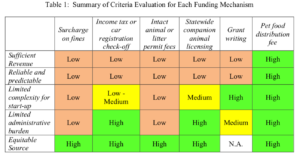
What House Bill 53 does:
- HB 53 will enact a modest fee paid by pet food manufacturers of $100/year for each product of dog and cat food and treats registered to be sold in New Mexico (added to the current $2 registration fee), phased in over a period of three years: $50 in 2020, $75 in 2021, and $100 in 2022 and beyond.
- It does NOT apply to:
- livestock feed or any other animal feed
- small businesses with annual gross revenue of $3 million or less
- prescription diets.
- Funding from the fee will pay costs of providing low-cost spay/neuter for animals of income-qualified New Mexicans in areas most in need (after 4% will go to NM Department of Agriculture to fund pet food registration enforcement, and up to 5% of remaining fee revenues may be used by NM Board of Veterinary Medicine for enforcement of the Animal Sheltering Act).
- The bill includes a 6-year sunset clause so the Legislature can assess the effectiveness of the fee increase.
- A similar bill passed the State Legislature in 2018 by a bipartisan 30-4 Senate vote and 48-19 House vote.
| ESTIMATED REVENUE (dollars in thousands) | Recurring or Nonrecurring | FUND/ENTITIES AFFECTED | ||
| 2020 | 2021 | 2022 | ||
| $624.7 | $937.1 | $1,249.4 | Recurring | Animal Care & Facility Fund |
| $27.4 | $41.1 | $54.8 | Recurring | New Mexico State University Operating Funds |
| $32.9 | $49.4 | $65.8 | Recurring | NM Board of Veterinary Medicine Operating Funds |
| ESTIMATED ADDITIONAL OPERATING BUDGET IMPACT (dollars in thousands) | Recurring or Nonrecurring | FUND/ENTITIES AFFECTED | |||
| 2020 | 2021 | 2022 | 3 Year Total Cost | ||
| ($27.4) | ($41.1) | ($54.8) | ($123.3) | Recurring | New Mexico State University Operating Funds |
| ($32.9) | ($49.4) | ($65.8) | ($148.1) | Recurring | NM Board of Veterinary Medicine Operating Funds |
| (Indeterminate)* | (Indeterminate)* | Recurring | Local Government Funds | ||
(Parenthesis ( ) Indicate Expenditure Decreases)
*Based on documented costs of animal control, care, and euthanasia in NM and intake/euthanasia reduction data from another state that recently raised pet food registration fees to fund spay/neuter, Animal Protection Voters estimates that local government animal control and shelters will see a recurring cost-savings of approximately $500,000/year.
Why do we need to fund spay/neuter?
This effort responds to a history of requests from the State Legislature and state agenciesto develop affordable and accessible spay/neuter resources in our state. A feasibility study on funding mechanisms requested by Senate Memorial 36 (2011) prepared for the Animal Sheltering Board, together with a comprehensive animal shelter survey conducted by Animal Protection of New Mexico, has found:
- New Mexico’s local governments and non-profits spend $38.5 million in tax and donor dollarsto fund animal care, control and spay/neuter services—a number that has increased over time.
- Over 135,000 dogs and cats enter New Mexico’s animal shelters every year—abouthalf are euthanized.
- Rural counties have the greatest need: Euthanasia rates are as high as 60%-85%.
- 2/3 of New Mexico counties have inadequate spay/neuter services.
What about other existing funding mechanisms? The NM Legislature has already created a spay-neuter license plateand a voluntary tax check-off program, but they have not generated nearly enough income for a comprehensive, statewide, subsidized spay/neuter program. The pet food manufacturer fee increase proposed by HB 53 is the best and only remaining feasible funding mechanismappropriate for New Mexico that is not already enacted. The following is an excerpt from the independent feasibility study that compared different funding mechanisms.

The Feasibility Study compared multiple known funding mechanisms used for spay/neuter services and determined the mechanism identified in HB 53 as the best option.
How are statewide spay/neuter funds administered in New Mexico?
Funds will be administered by the NM Board of Veterinary Medicine, based on recommendations by its animal sheltering subcommittee.
How much funding would the additional fee provide for low-cost spay/neuter?
At the completion of the phase-in, the fee is expected to generate an estimated $1.37 million per year, with more than $1.2 million annually dedicated to sterilize an estimated 16,000-22,000 dogs and cats of income-qualified New Mexicans.
This approach is PROVEN to be effective to reduce shelter pet euthanasia.
Other states—West Virginia, Maine, and Maryland—have increased or added fees for spay/neuter onto existing pet food registration fees. Notably, Maryland passed legislation in 2013 raising pet food registration fees to $100 over the course of three years and reports a decrease in intake and dramatic 29% reduction in euthanasia.
Why this legislation makes sense: Several other states charge pet food manufacturers up to $100 per product for sale in those states. New Mexico currently charges only $2/year per product. We are missing out. HB 53 would keep our pet food registration fees in line with what other states charge, but dedicate that money to low-cost spay/neuter services.
How will the bill impact consumers or retailers?
If pet food manufacturers pass the fee to consumers by proportionally raising retail prices, it will average only $0.69 to $1.38 per year per dog/cat (as it phases in). The best available data from states who have implemented similar pet food registration fee increases shows zero to negligible impact on consumer costs, retail pet food prices, and availability of product variety in those states. For example, since enacting a pet food manufacturer increase in Maine, the state reported a decrease in euthanasia, but also an increase in the number of pet food/treat products registered for sale.
Read more about these impacts in our blog.
